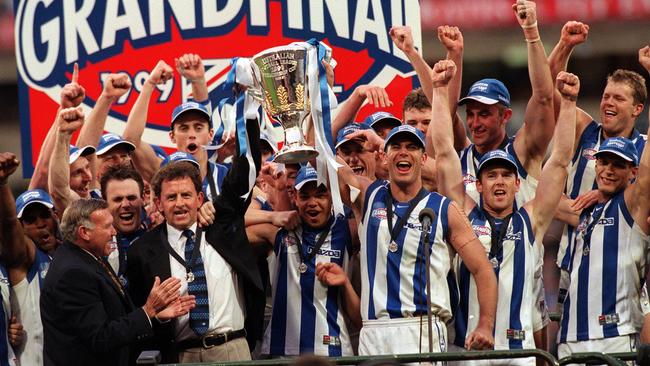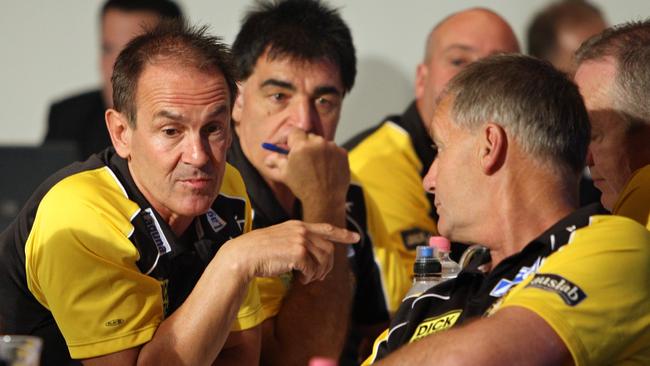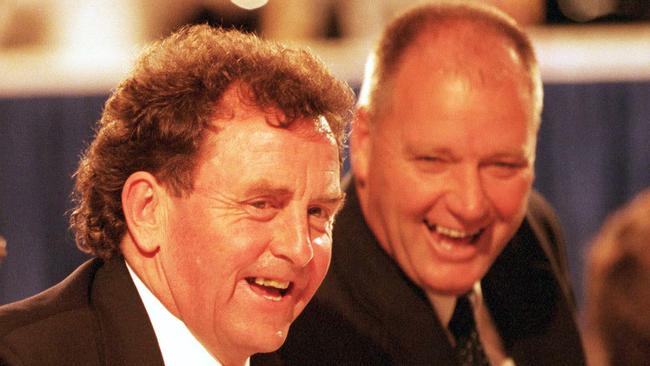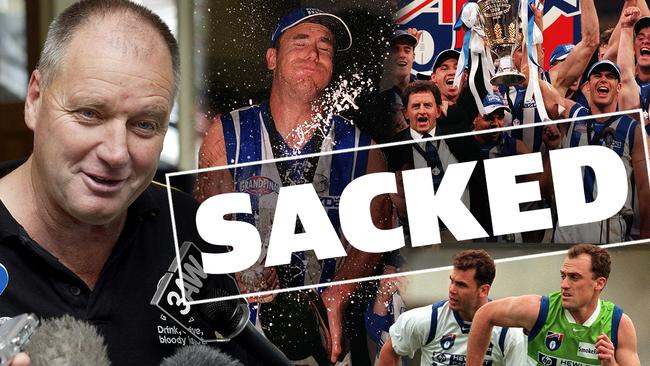During the 1980s and ’90s, recruiters had to be part secret agent, part spruiker, part salesman and part sleuth. And few were better than Greg Miller. He joins the Sacked Podcast and goes behind the scenes on the wheeling and dealing.
It was the ultimate payback that helped shape the destiny of two clubs.
And for Greg Miller, it was one of the many tricks of the trade that highlighted the shenanigans footy recruiting agents got up to in the 1980s and ’90s.
In those times recruiters had to be part secret agent, part spruiker, part salesman and part sleuth. The best became the masters of dodgy paperwork, fake addresses, hiding players, cash and car inducements, and the art of making the deal when others couldn’t.
Miller was one of the most resourceful along with contemporaries Graeme “Gubby” Allan and Shane O’Sullivan, believing they could “beat the system” – which they frequently did.
As he stepped into the lift at the VFL’s Jolimont headquarters one day in 1987, opportunity wasn’t necessarily knocking, it was staring Miller in the face.
Sharing the tight confines of the lift that day was Sydney’s general manager Ron Thomas.
In the time it took for the lift to descend, Miller – who had been sacked by the Swans as their recruiting boss only a few years earlier and was now working at North Melbourne – struck a deal to pay Sydney $70,000 for two Swans-zoned teenagers – $60,000 for a kid from Corowa and $10,000 for another youngster from Wagga.
SUBSCRIBE TO THE SACKED PODCAST
The North Melbourne administrator had just brokered one of the biggest recruiting heists in footy history – even if he wasn’t sure his club could pay for it.
“By coincidence I ran into (Thomas) … in (Sydney’s) defence they were developing a good side and the kids didn’t matter to them as much” Miller explained in the Herald Sun’s Sacked podcast. “I was in a lift at (VFL) House and ran into (Thomas).
“We talked about John Longmire and we offered 60 grand and we got him for 60 grand. At the last minute we chucked in the 10 grand for Wayne Carey. I will never forget it.”
Neither will Sydney.
Carey and Longmire went on to collectively play 472 games and kick 1238 goals. Longmire became a North Melbourne great; Carey became an all-time great.
Miller quickly dialled the Kangaroos’ home base, pleading for the man controlling the purse strings to check if there was enough cash in the Arden St safe to pay for it.
“Seventy grand for North Melbourne was a lot of money,” Miller said. “I rang Ron (Joseph) and said, ‘I need 70 grand and I need it right now’.

“He went silent on the phone. He went and got (club treasurer) Jimmy Hannan (who) got the journal out and had the pen and paper out, and I said: ‘Jimmy, I need 70 grand, can you drive it in to me?’ And (thankfully) he did.”
Deal done.
While Miller’s act that day 35 years ago wasn’t motivated as payback for his own sacking, he wonders what might have happened if he had stayed at the Swans.
“They (Sydney) basically dismissed all of us,” Miller said of the administrative cull in the mid-1980s. “What they didn’t understand was the fallout of all that.
“They lost a lot of good people. They lost me … and (lost) what I had going on behind the scenes which they couldn’t have been aware of. I had a relationship with all the juniors who turned out to be Carey and Longmire.
“I had signed up Peter Motley (who later went to Carlton), Greg Anderson (Essendon), Gavin Crosisca (Collingwood) and Shaun Smith (North Melbourne).”
The Swans finished third in 1987, but crashed out of the finals in straight sets.
Within a handful of years, the club Miller had loved so dearly since he was a kid was under threat and his new club, North Melbourne, was working towards a successful 1990s.
INSIDE THE HITS
THE first rule of recruiting, according to Miller, is “possession is nine tenths of the law.”
The example of Mark Bayes taught him that.
Bayes played almost 250 games for Sydney and sits 12th on the club’s all-time games list, but he would have played at the Bulldogs, if not for Miller’s intervention.
Miller explained: “One of the best I did was Mark Bayes … his mum and dad were separated – his mum lived in the Bulldogs’ zone and his dad lived in St Kilda’s zone.
“So I rented his dad a house across the road in the Swans’ zone and shifted his dad and changed the kid’s address to his address, even though he was never living with his dad.”
Miller had earlier recruited David Rhys-Jones and a flashy forward called Warwick Capper.
Years later, he was impressed by a kid playing under-13s and 14s who was “belting blokes, taking screamers and fighting with the umpire”. The only problem was that the kid – Glenn Archer – was residentially tied to St Kilda.
“He wasn’t a North Melbourne player at all,” Miller said. “He was St Kilda’s. When he was looking at the (recruiting) form, he said: ‘F — this, change this (on the form), change that. And he becomes the Shinboner of the Century.”
Miller had similar success in being able to wrest Alastair Clarkson from Essendon’s grasp, even if a rival club tried to supplant them both.
“One of the ploys we had was to get kids from all the club zones down in grand final week and we would give them a grand final standing room ticket,” Miller said. “We would put them up in Schimma’s (Wayne Schimmelbusch) house and get them to play in a game out at Waverley the day after the grand final.

“I had Alastair Clarkson come down with Craig Sholl and Wayne Schwass. ‘Clarko’ and ‘Sholly’ weren’t on Essendon’s top 50 junior list, but in July Don Hanly from the AFL rang me and said Al Clarkson had gone to St Kilda.
“I rang Al up and said ‘What’s going on? Have you signed with St Kilda?’ He said ‘I haven’t signed with St Kilda’, so Don Hanly gets the form and they say, ‘They are not our signatures’.
“We moved Wayne Schwass into Schimma’s house and only told Fitzroy afterwards, and we brought Sholly down as well.”
Miller put countless kilometres on the speedo. Having targeted Nathan Buckley as a Port Adelaide reserves player, he drove from Adelaide to Alice Springs to watch Buckley play and discovered a shooting star called Adrian McAdam.
“I watched the Buckley and McAdam show,” he said of the Alice Springs game. “Buckley was kicking goals from the wing and dominating and McAdam kicked about eight goals.
“I thought (I had found) two superstars in one game.”
While Buckley never played a game for Miller’s team, despite signing a deal and getting a $10,000 sign-on fee (which he returned), McAdam kicked 68 goals in his first season with North Melbourne.
But his form swiftly faded. So what went wrong?
“It just got to his head,” Miller said of McAdam. “The first thing that brought him undone was that the umpires gave him six free kicks against Michael Gayfer and he thought free kicks were easier than marking, so he started staging a bit.”
INSIDE THE MISSES
MILLER still laments a clerical error that cost him a Brownlow medallist, but he has long since reconciled with the fact that one of the game’s greatest goalkickers slipped the net in 2004.
The Brownlow medallist was Scott Wynd, who was in the Kangaroos’ zone.
“I lost Scotty Wynd (who won the 1992 Brownlow Medal with Footscray),” he said. “It was a clerical error. You had to put them on your list at sixteen-and-a-half and he was going to go on to our list. But I had his birthday as the first of May, but it was actually the fifth of the first (January 5). We had it back to front (and lost him to the Dogs).
“I’m not blaming anyone, but the recruiting officer had it (his birthdate) in a different style.”
In trying to make up for the mistake a few years later, he made it even worse. Miller chose Scott’s brother Paul Wynd and in the process missed the chance to secure Chris Johnson.
“I thought I am not going to lose another Wynd,” he said. “So I grabbed him and Chris Johnson would have been the other choice.”
Paul Wynd played three games for the Kangaroos; Chris Johnson played 264 for the Lions.
When the Swans went to Sydney, Miller reluctantly relinquished the club’s rights on Darren Millane (to Hawthorn in a move that lasted barely one session) and Ian Fairley (North Melbourne), who had no intention of moving to the Harbour City.

But Miller said Richmond’s failure to draft Lance Franklin with its first two picks in the 2004 national draft was what almost every other AFL club would have done at the time.
The Tigers chose Brett Deledio with pick No. 1 and Richard Tambling pick No. 4, while Hawthorn pounced on Franklin at five, having already chosen Jarryd Roughead at two.
The Bulldogs also bypassed Franklin at pick No. 3, choosing Ryan Griffen instead.
“I never felt that Franklin was better than (pick) five at the time,” Miller said. “I think he was No. 5 on everyone’s list.
“The Bulldogs didn’t and neither did Hawthorn (who chose Roughead ahead of him). But he obviously turned out to be a better player than Richard Tambling.
“I really wanted Roughead. I thought we had him.”
Miller conceded the decision to overlook Franklin ended up being “a nail in my coffin” as he conceded that Richmond’s lack of resources and funding in recruiting cost the club dearly.
Franklin has now kicked 1004 from 322 games; Tambling played 124 games for Richmond and Adelaide and has been retired since the end of 2013.
SOUTH TO SYDNEY
FROM being a South Melbourne cheer-squad member to Swans under-19s player within a week – that was Miller’s early football path. He ended up playing 52 senior games, emulating his father who also played for the club.
He was a no-nonsense full-back who got to play on some of the great full-forwards from 1972 to 1976 before knee injuries stopped him.
But the Swans saw potential in Miller’s ability to recognise football talent so he became the club’s recruiting manager at a young age.
Money was tight and the support base was dwindling, so he played a role in helping to get South Melbourne to Sydney for the start of the 1982 season.
He helped set up the club in Sydney, working on building a team and on getting the facilities right in a rugby league-dominated state.
All that came to a crushing end when he was sacked by the club in 1984, leading to his move to North Melbourne.
LIFE AT THE ROOS
MILLER helped build the North Melbourne teams that played off in seven consecutive preliminary finals and won flags in 1996 and 1999, as well as serving as chief executive.
He loved the challenge, even if there were some exceptionally tough times.
Part of that was the sacking of his close mate Wayne Schimmelbusch as coach in early 1993 after a disastrous pre-season game.
“Schimma didn’t know it, but the story got out,” Miller said of how veteran journalist Scot Palmer broke the news.
“A champion shouldn’t be hearing it from the media. That was our fault as a club.”
Miller drew up the shortlist to replace Schimmelbusch, which included Denis Pagan, Dermott Brereton and Rodney Eade.
Brereton chose not to be interviewed and Pagan edged out Eade.
Pagan and Eade squared off three years later in the 1996 grand final as North Melbourne and Sydney coaches.
The Kangaroos won the flag, just months after being jilted over a proposed merger with Fitzroy.

“It is the only gold (premiership cup) in existence, so it was (a moment) of immense pride,” he said of the 1996 triumph. “When you are out on the ground and you see what it means to the supporters, it felt like you knew every one of them, and in a way, you did.”
A second flag came in 1999, as the Kangaroos – battlers in a financial sense – beat the blue bloods from Carlton.
Only once was Miller fined for breaking the rules, costing $20,000. But the very next week the AFL “donated” exactly the same amount for an upgrade of the Kangaroos’ under-19s facilities – which hadn’t been requested.
Miller later moved to Richmond where he took on a number of roles, including footy boss, recruiting advisor and board member for a time, but couldn’t replicate the same success before he was ultimately sacked in 2008.
CAREY CRISIS
ONE of Miller’s saddest moments came after he left the Kangaroos when Carey was forced to quit the club ahead of the 2002 season.
As a close confidant of Carey, Miller was called in to some of the tense meetings following revelations Carey had been caught cheating with a teammate’s wife – a moment Carey said recently was the biggest regret of his life.
Miller initially thought there could be a hope Carey could stay at the club, but that was never going to happen.
“You had the sense the anger was immense and the disappointment was such that it wasn’t going to work,” he said.
“All Wayne could do was have his head down and apologise.
“I was around the corner when (the news broke). He rang me and I went around there and spent the next couple of weeks with him. It was traumatic to say the least.”
Carey left the club immediately and returned for two seasons at Adelaide in 2003-04.
“Wayne (ended up) playing in Adelaide, (and) a whole new world had opened up in Adelaide that he hadn’t seen in Melbourne,” Miller said. “In some ways that sent him down the wrong track for a while.
“But it is good to see him now. I still see him. He is a great father. ”


Add your comment to this story
To join the conversation, please log in. Don't have an account? Register
Join the conversation, you are commenting as Logout
‘He’ll stay a Carlton man’: Strong Voss shuts down Curnow talk
Carlton coach Michael Voss has emphatically declared Charlie Curnow is off the trade table as the star Blue returned to training today. Josh Barnes has more.
TV Wrap: Showdown deserves more, Curnow floats trade chance
There’s been a renewed push for a standalone Showdown, plus plenty of people weigh in on what a Charlie Curnow trade scenario looks like. All the headlines from Tuesday night’s shows.